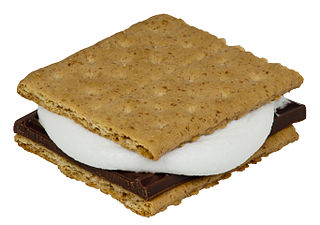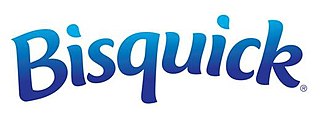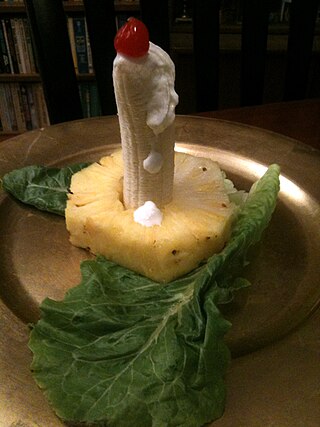
General Mills, Inc. is an American multinational manufacturer and marketer of branded ultra-processed consumer foods sold through retail stores. Founded on the banks of the Mississippi River at Saint Anthony Falls in Minneapolis, the company originally gained fame for being a large flour miller. It is headquartered in Golden Valley, Minnesota, a suburb of Minneapolis.

A s'more is a confection consisting of toasted marshmallow and chocolate sandwiched between two pieces of graham cracker. S'mores are popular in the United States and Canada, and Slovenia, they are traditionally thrown in a campfire.

Betty Crocker is a brand and fictional character used in advertising campaigns for food and recipes. The character was created by the Washburn-Crosby Company in 1921 to give a personalized response to consumer product questions. In 1954, General Mills introduced the red spoon logo with her signature, placing it on Gold Medal flour, Bisquick, and cake-mix packages. A portrait of Betty Crocker appears on printed advertisements, product packaging, and cookbooks.

Red velvet cake is traditionally a red, crimson, or scarlet-colored layer cake, layered with ermine icing or cream cheese icing. Traditional recipes do not use food coloring, with the red color possibly due to non-Dutched, anthocyanin-rich cocoa, and possibly due to the usage of brown sugar, formerly called red sugar.

A fat rascal, closely related to the historical turf cake, is a type of cake, similar to a scone or rock cake in both taste and ingredients. It originated in Yorkshire at least as early as the 19th century.

Depression cake is a type of cake that was commonly made during the Great Depression. The ingredients include little or no milk, sugar, butter, or eggs, because the ingredients were then either expensive or hard to obtain. Similar cakes are known as "War Cake", as they avoided ingredients that were scarce or were being conserved for the use of soldiers. A common depression cake is also known as "Boiled Raisin Cake", "Milkless, Eggless, Butterless Cake", or "Poor Man's Cake". "Boiled" refers to the boiling of raisins with the sugar and spices to make a syrup base early in the recipe. However, some bakers do include butter. Boiled raisin-type cakes date back at least to the American Civil War.

Bisquick is a baking mix sold by General Mills under its Betty Crocker brand, consisting of flour, shortening, salt, sugar and baking powder.

John Crosby III was an American businessman. Crosby was a founding partner of the Washburn-Crosby Company, the forerunner to General Mills.

Corn chowder is a chowder soup prepared using corn as a primary ingredient. Basic corn chowder is commonly made of corn, onion, celery, milk or cream, and butter. Additional ingredients sometimes used include potatoes or squash, salt pork, fish, seafood and chicken. In the United States, recipes for corn chowder date to at least as early as 1884. Corn chowder is mass-produced as a canned food in the U.S.

Spoonbread is a moist cornmeal-based dish prevalent in parts of the Southern United States. While the basic recipe involves the same core ingredients as cornbread – namely cornmeal, milk, butter, and eggs – the mode of preparation creates a final product with a soft, rather than crumbly, texture. As the name implies, the consistency is soft enough that it needs to be served and eaten with a spoon.

Marjorie Husted was an American home economist and businesswoman who worked for General Mills and was responsible for the success and fame of the brand character Betty Crocker. Husted wrote Betty Crocker's radio scripts and was her radio voice for a time.

The Betty Crocker Cookbook is a cookbook written by staff at General Mills, the holders of the Betty Crocker trademark. The persona of Betty Crocker was invented by the Washburn-Crosby Company as a feminine "face" for the company's public relations. Early editions of the cookbook were ostensibly written by the character herself.
Anna & Kristina's Grocery Bag was a Canadian television series that aired on the W Network and OWN Network in Canada, as well as 13 other countries around the world. Similar to the series The Shopping Bags, produced and hosted by Anna Wallner and Kristina Matisic, this series focuses on the kitchen, putting cookbooks, kitchen products, and cooking ingredients to the test.

Mill City Museum is located in the ruins of the Washburn "A" Mill next to Mill Ruins Park on the banks of the Mississippi River in Minneapolis. The museum, an entity of the Minnesota Historical Society that opened in 2003, focuses on the founding and growth of Minneapolis, especially flour milling and the other industries that used hydropower from Saint Anthony Falls. The mill complex that the museum is within, dates from the 1870s and is listed on the National Register of Historic Places. It is also part of the St. Anthony Falls Historic District and within the Mississippi National River and Recreation Area.
Margo Oliver was a Canadian cookery expert. She was the food editor of Weekend Magazine and wrote a number of cookbooks as well as articles on the subject of cooking.

Candle salad is a vintage fruit salad that was popular in America from the 1920s through to the 1960s. The salad is typically composed of lettuce, pineapple, banana, cherry, and either mayonnaise or, according to some recipes, cottage cheese. Whipped cream may also be used. The ingredients are assembled to resemble a lit candle.
Bacon cake is a cake made with bacon, either savory or sweet, and generally baked in an oven, although it's sometimes cooked in a skillet on a range top.

A baking mix is a mixed formulation of ingredients used for the cooking of baked goods. Baking mixes may be commercially manufactured or homemade. Baking mixes that cater to particular dietary needs, such as vegan, gluten-free, or kosher baking mixes, can be bought in many places.
In the 1950s, commercial cookbooks gained popularity in the United States. These cookbooks frequently suggested the use of packaged food and electric appliances, which had become more available due to the post-war economic boom. Cookbooks reflected these changes. Betty Crocker and Julia Child became popular icons in American culture through their cookbooks and the media during this era. Cookbooks also reflected many cultural trends of the 1950s, especially typical gender roles and racial identities. Many cookbooks were addressed to the white, middle-class housewife who cooked for her family in their suburban home. These cookbooks often excluded African-American, immigrant, and rural women. For them, handwritten cookbooks served as both personal histories and a means to express their views on politics and society. Meanwhile, advertisements promoted the racial stereotype of the “black mammy” that de-feminized African-American cooks in white households. Ethnic immigrants were also debased as European Americans baked their distinct cuisines into generic casseroles.
Agnes White Tizard was an American home economist and nutrition consultant who worked for General Mills and was associated with the brand character Betty Crocker. Tizard was the voice of Crocker on the radio for 20 years, and wrote the original Betty Crocker Cookbook in 1950. Tizard was the first host of a radio cooking program in the United States.















